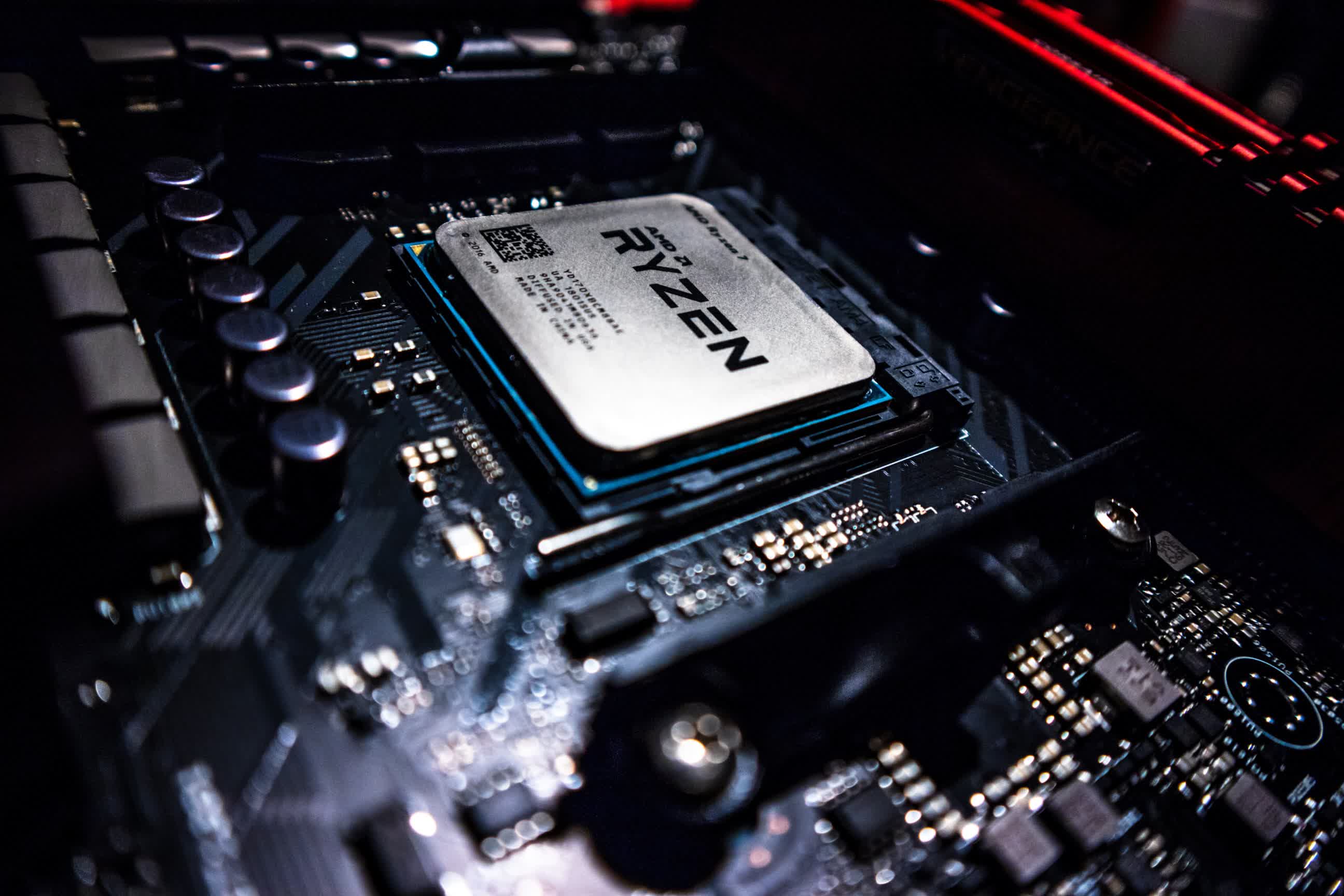Today we're taking an updated look at the gaming performance of the Ryzen 7 2700X and comparing it with more modern 8-core, 16-thread CPUs such as the Ryzen 7 5800X and Intel Core i7-11700K. The 2700X is a CPU that we really liked for productivity tasks, but weren't entirely sold on its gaming performance.
At the time, we felt for gaming the Core i7-8700K was probably a better choice as it was faster in almost every instance and it was roughly the same price. For those building a high-end gaming system, the non-X Ryzen was also compelling at $300, but if you were after maximum gaming performance, again the Intel CPU seemed like the way to go. That said, for more affordable gaming setups the Ryzen 5 2600 was a great value option and one that we frequently recommended. All in all, it was hard to ignore either Ryzen for gaming due to the AM4 platform advantages and the potential to upgrade to the next few generations of Ryzen CPUs.
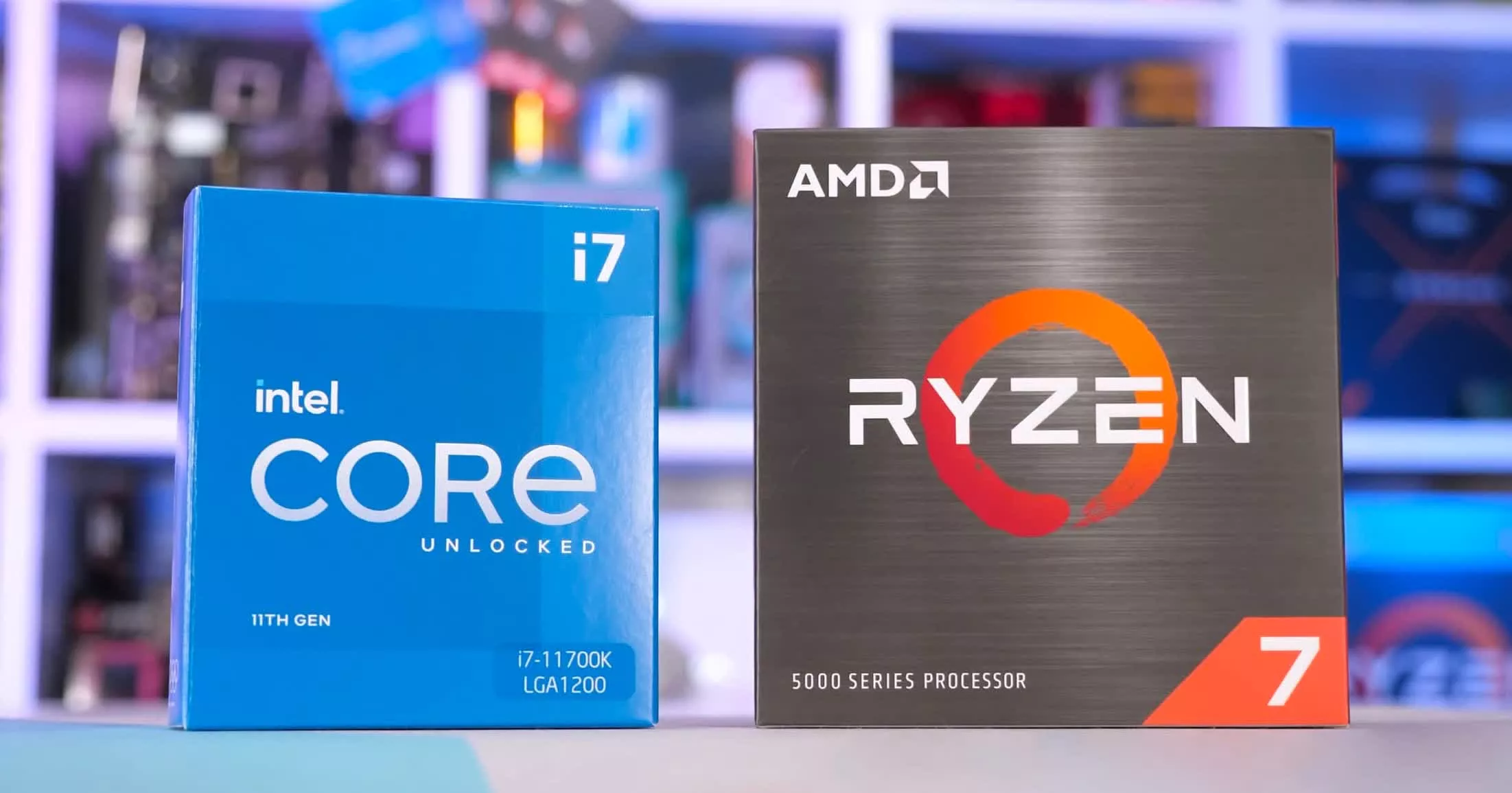
If you did go with the Ryzen 7 2700X (which is now 3-years-old) and you're wondering how it is holding up in 2021, and what does the upgrade to the 5800X look like, today we're going to answer both of those questions with a 30 game benchmark.
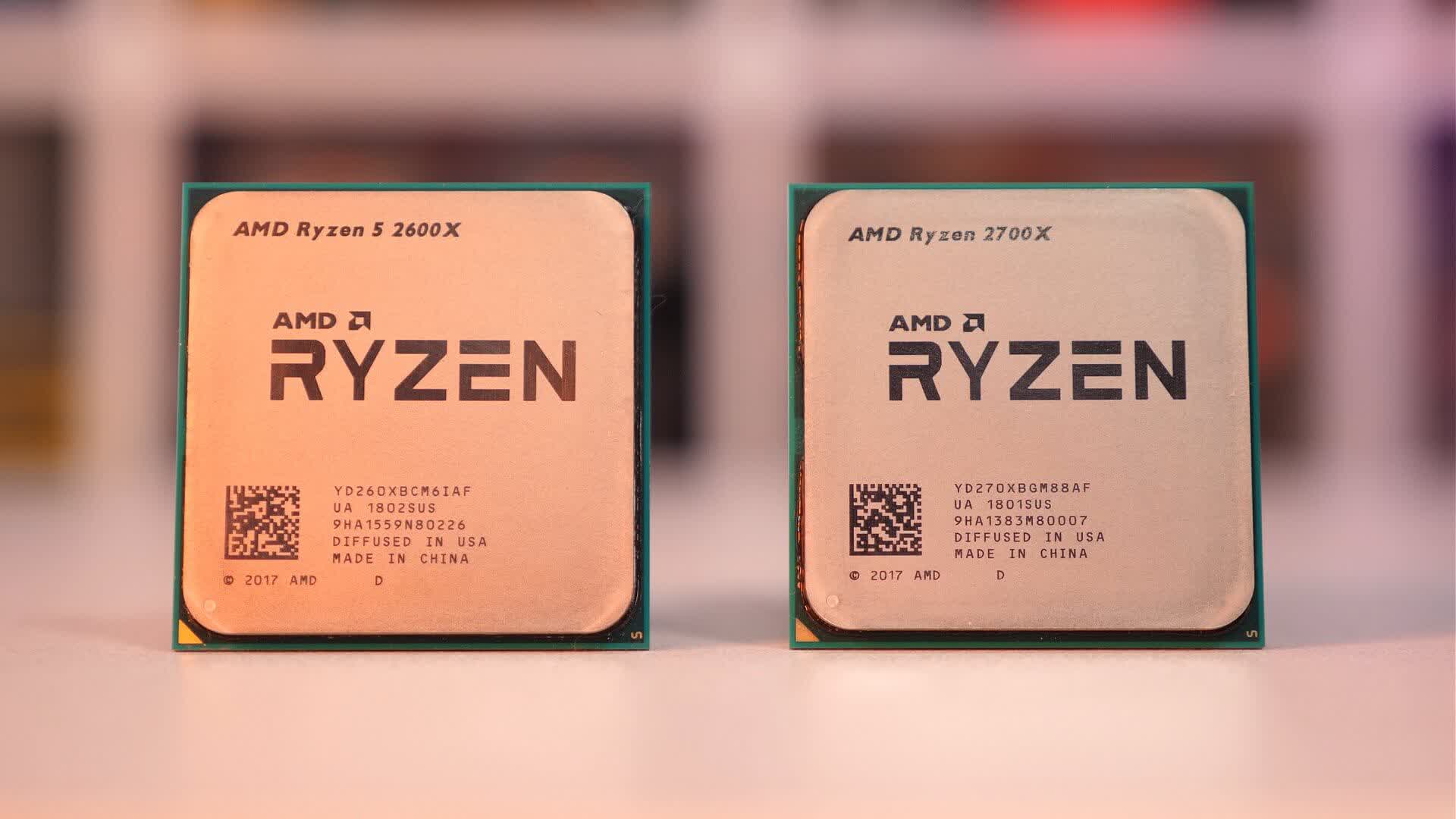
All CPUs were configured with 32GB of DDR4-3200 CL14 dual-rank, dual-channel memory. For the motherboards, the AM4 platform is represented by the MSI X570 Unify running the latest BIOS and for the LGA1200 platform the Gigabyte Z590 Aorus Master. We've tested 30 games at 1080p, 1440p and 4K using the Radeon RX 6900 XT. We'll look at the data for about a dozen titles and then get into the usual data breakdown. So let's do it...
Gaming Benchmarks
Starting with Battlefield V we find some interesting results. Initially Battlefield 1 was used for comparing these CPUs and once we moved to Battlefield V, we were using much slower GPUs in 2018 and 2019, such as the GTX 1080 Ti and RTX 2080 Ti. The 6900 XT on the other hand can push well over 200 fps at 1080p and 1440p, in fact even with the fastest 8-core CPUs available today, we're still primarily CPU limited at 1080p.
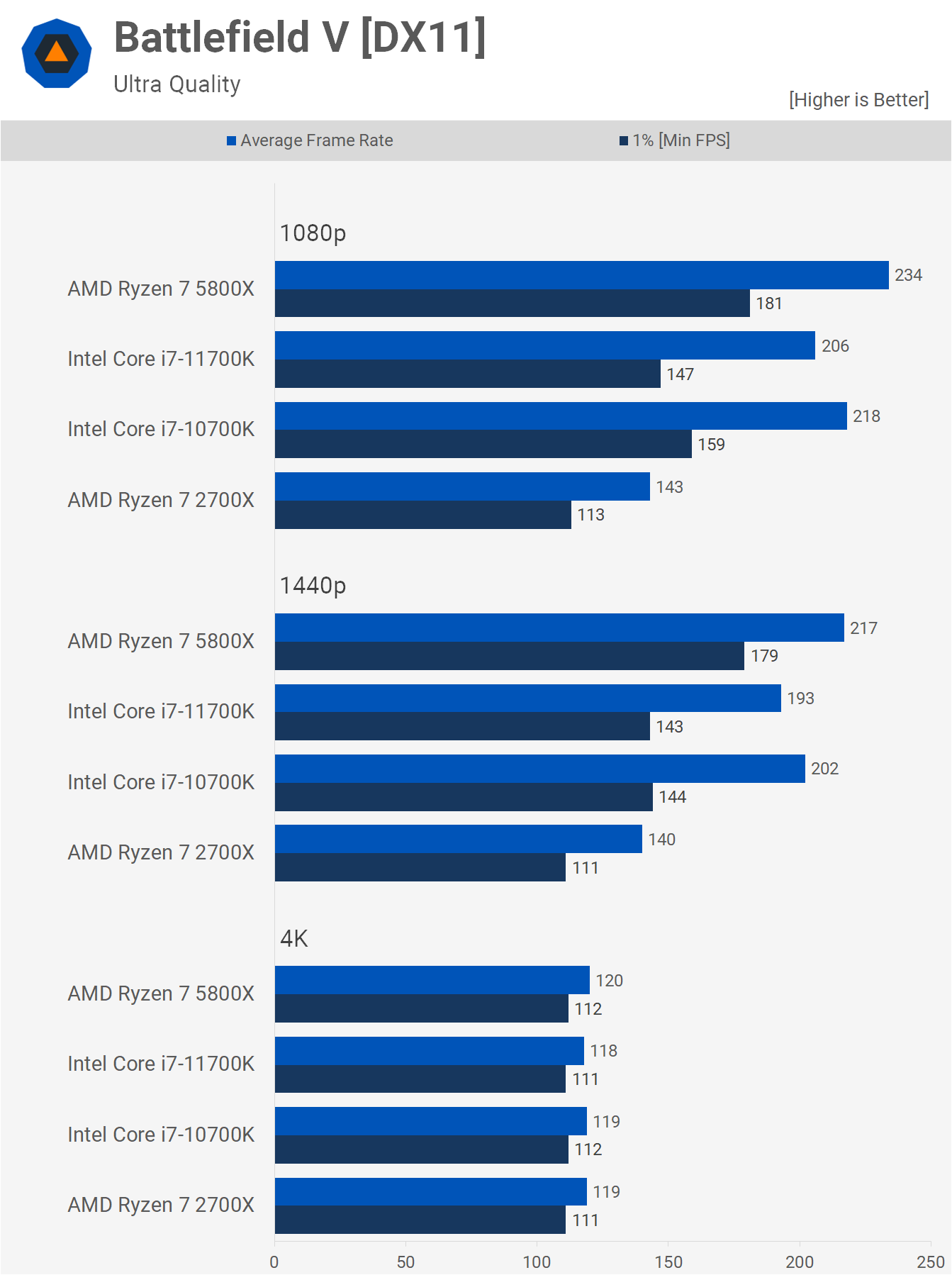
So while the 2700X was good for 143 fps on average, which is a respectable level of performance, it's nothing like the 234 fps we received with the newer 5800X, that's an incredible 64% performance boost. It's also well worth noting that the 10700K – which is essentially a 9900K – was still 52% faster than the 2700X and we also saw similar margins at 1440p.
It's not until we reached the 4K resolution using the ultra quality preset that the game became entirely GPU limited using all four configurations. Still, it's remarkable just how much slower the 2700X is than parts like the 5800X, 11700K and 10700K when CPU limited, using the fastest 1080p gaming graphics card available. On that note, if I was to run these tests again using an RTX 2080 Ti the margins would be smaller and then a lot smaller with the 1080 Ti.
As an example, the RTX 3070 will limit performance at 1080p to around 170 fps and that would reduce the margin between the 2700X and 5800X to around 20%, so less than half of what's shown here. But if you use lower quality settings at 1080p or 1440p, then that will once again open up the margin, even with the lower tier GPU.
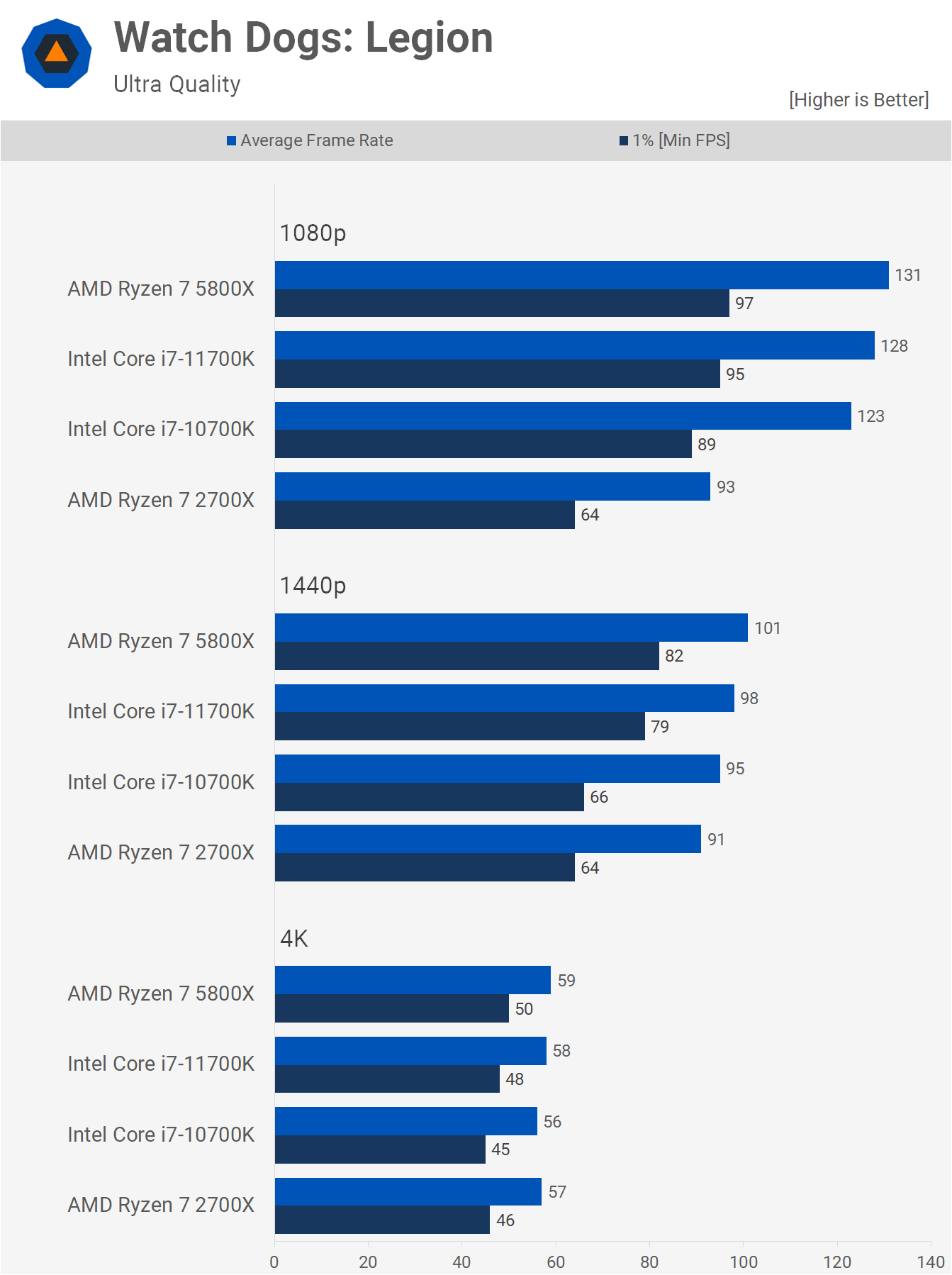
Watch Dogs: Legion is another CPU demanding game and here we find the 2700X lagging behind quite a lot at 1080p and as a result this time the 5800X was 41% faster, though it's worth noting the margin was even larger when comparing the 1% low performance, blowing out to 52% in favor of the new 5000 series part. The Core i7-10700K which again is basically a 9900K, was almost 40% faster when comparing 1% low performance.
By the time we reach 1440p with the 6900 XT, the margin between the 2700X and 10700K shrinks to basically nothing.
The 5800X is up to 28% faster and that is significant, though we only see an 11% difference when comparing the average frame rate. Then at 4K, the game becomes entirely GPU limited, so all four configurations produced basically the same result.
The fact that the 2700X can produce a 1% low of over 60 fps and an average frame rate of around 90 fps, means for most configurations gamers will still be GPU limited with this CPU, as the priority for a game like Watch Dogs Legion is typically visual quality over high frame rates, a 90 fps average will most certainly do here.

A game where you might require high frame rates is F1 2020 and here the 2700X does well, pushing up over 200 fps at 1080p. The 5800X and Intel 10th and 11th-gen CPUs were still much faster, delivering just over 40% more frames, but I think for this title that's an unnecessary improvement.
Even at 1440p where the margin shrinks to 18% in favor of the 5800X, the older 2700X is pushing near 200 fps. We see a slight performance discrepancy at 4K, but the 2700X still allowed for 137 fps on average. So while slower than the more modern CPUs, this isn't a game where the 2700X suffers to a noticeable degree.

A game where it does suffer to a noticeable degree is Microsoft Flight Simulator 2020. The best the Ryzen 7 2700X can muster here is 38 fps on average and that makes the 5800X ~45% faster. That's an important margin that radically changes how the game plays.
A similar margin is seen at 1440p and it's not until we reach 4K that the GPU becomes the primary performance limiting component, but even then the 1% low performance is noticeably worse with the older Zen+ processor.

The 2700X is well down on the modern 8-core processors in Cyberpunk 2077, especially when looking at 1% low performance. For example at 1080p the 5800X was almost 60% faster and we're still looking at around a 25% margin at 1440p, though the average frame rate is comparable, but it's the 1% lows that you'll notice.
For mid-range to lower-end gaming systems with GPUs only capable of around 60-90 fps at 1440p the 2700X won't be letting you down, but for higher end GPU configurations you'll want to upgrade the CPU.

Testing with Star Wars Jedi: Fallen Order shows that at 1080p and 1440p, the 5800X offers ~36% more performance and it's not until we reach 4K that the game becomes GPU limited.
As was the case with Watch Dogs Legion, this is single player title where gamers are likely going to prioritize visuals and in terms of performance likely only require around 60 fps for an enjoyable experience, though personally I prefer around 90 fps for smoother input. Point is, you can roughly achieve that with the old 2700X, and it's really only high-end GPU configurations that will benefit from a faster CPU.

Call of Duty Warzone is a game like Battlefield V where I expected the 2700X to suffer badly, but to my surprise it does okay. Sure, the 5800X offers almost 50% more performance at 1080p when comparing 1% low data, and the Intel 10th and 11th-gen 8-core models are also much faster, but with 172 fps on average and a 1% low of 131 fps, the 2700X is hardly slow and does allow for high refresh rate gaming.
Moreover, the margin is significantly reduced at 1440p, where the 5800X is up to 24% faster when comparing 1% lows and 14% faster on average. But with over 120 fps at all times and an average of 170 fps, the 2700X still enables a great gaming experience and will max out powerful GPUs such as the RTX 3060 Ti, for example.

Death Stranding is another one of those games where you don't need hundreds of frames per second and the 153 fps average we see with the 2700X is more than enough for high refresh rate gaming in this title.
We do see more evidence that points to Zen 3 along with Intel 10th and 11th-gen parts being faster for gaming. The 5800X was up to 44% faster at 1080p while the Intel CPUs were around 33% faster on average. The margins are reduced slightly at 1440p as the newer 8-core CPUs start to become GPU limited, and then at 4K we're looking at similar performance for all four configurations.

Shadow of the Tomb Raider is a CPU demanding single player game and although the 2700X was good for over 100 fps at 1080p and 1440p, it was still significantly slower than the modern options from AMD and Intel. We're talking about almost 60% greater performance with the 5800X and almost 50% with the 10700K.
As the game becomes more GPU limited at 1440p, that margin closes quite significantly, but even so the 5800X was still 21% faster when comparing the average frame rate and 36% faster when comparing the 1% low data. It's not until we hit the 4K resolution that the margins are neutralized across all tested configurations.

Surprisingly the 2700X hangs in there quite well in Tom Clancy's Rainbow Six Siege, showing the Vulkan implementation in this title is pretty good.
We're looking at well over 300 fps on average at 1080p with almost 300 fps for the 1% low, so pretty playable performance there. The 5800X is up to 52% faster which is a massive performance increase, but given how fast the 2700X is here, it's not very relevant in practical terms. Not only that, but by the time we reach 1440p the margins are reduced to single-digit figures.

These results are interesting as I suspect those playing War Thunder might want a little more performance than what the 2700X enables. Granted, it's still highly playable, but 1% lows of 86 fps might be less than ideal for competitive players.
The 5800X was up to 70% faster here, hitting 189 fps on average at 1080p for what is a truly massive performance uplift. Worse still, this game so heavily CPU bound that even when cranking the resolution up to 4K, the 2700X is still well over 20% slower than the modern 8-core AMD and Intel CPUs.

The last game we're going to look at in detail is the NPC-heavy Hitman 2.
Here the 2700X introduces a strong CPU bottleneck at 1080p and 1440p, and as a result the 5800X, 10700K and 11700K were 40% faster at 1080p and 1440p. As we've seen multiple times now, when we play at 4K the game becomes GPU bound and all CPUs enable similar levels of performance.
Performance Summary
Now it's time to compare these CPUs across all 30 games, starting with the 1080p data, so let's do that.
Here we're comparing the 2700X to the new 5800X and as you can see, on average the Zen+ processor was 23% slower. There were just four games where we saw single-digit margins, and eight games where the margin was 30% or greater. War Thunder, Battlefield V, Shadow of the Tomb Raider and World War Z were among the worst performers for the older CPU.

If you're using the 2700X with a modern high-end GPU, it's probably time to start considering a CPU upgrade and the 5800X is a good option, though perhaps look into the 5900X as it's typically a bit better in terms of value if you work and play.
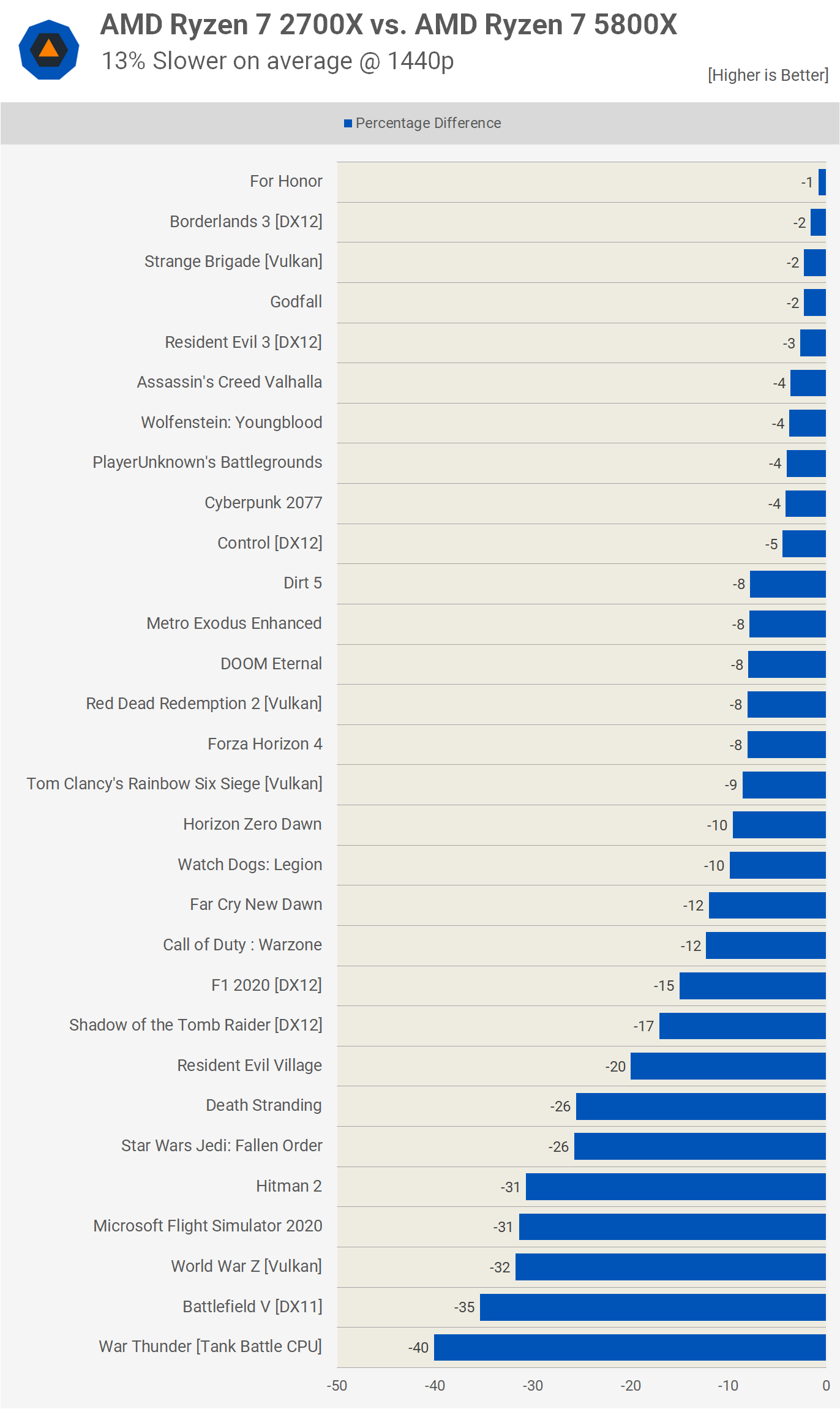
Of course, if you are gaming with a high-end GPU and super high frame rates aren't a priority, but instead you care more about image quality, at resolutions such as 1440p or greater, then CPU performance is a little less of an issue.
Here the 2700X was just 13% slower than the 5800X on average, though we do have eight games where the performance margin was 20% or greater.
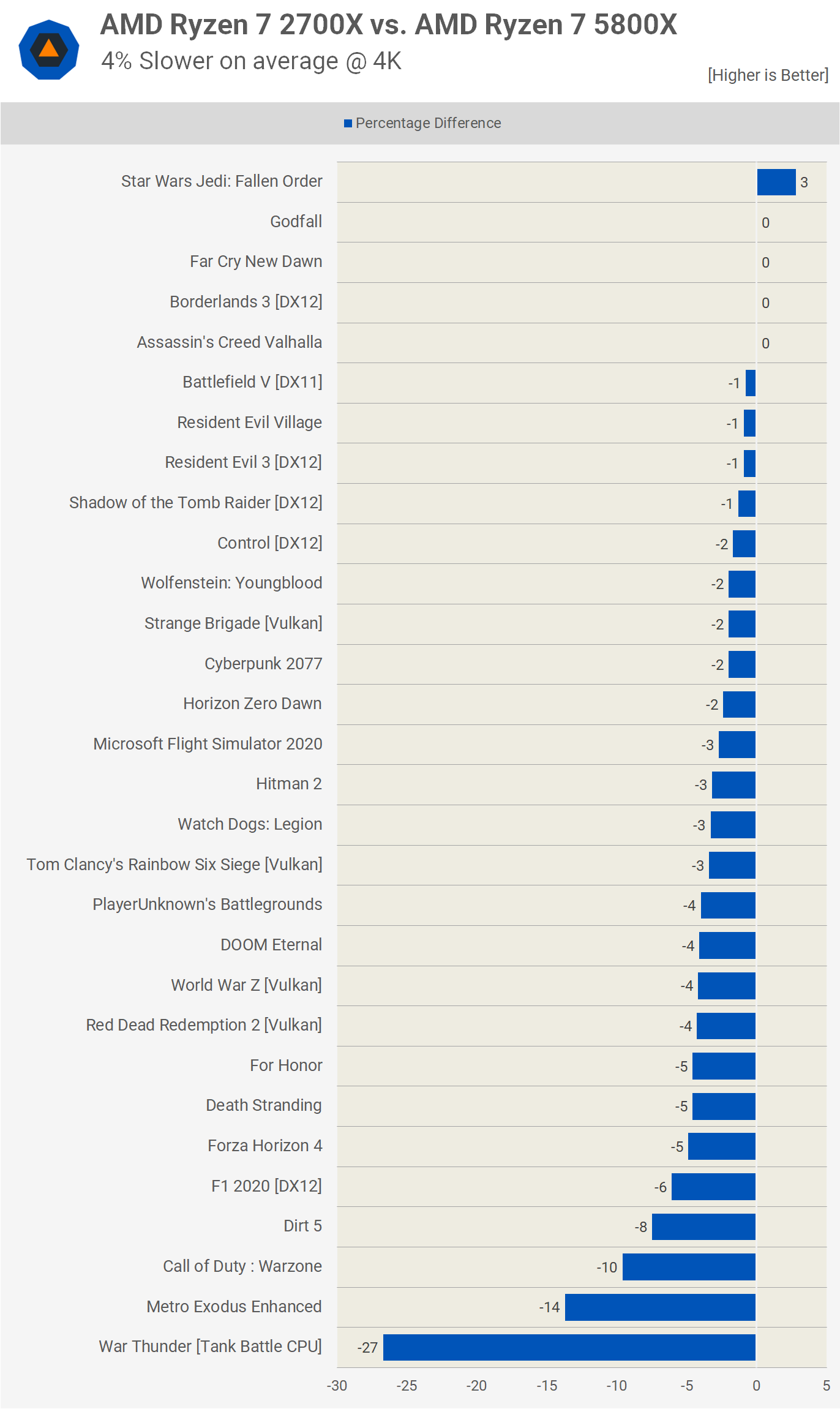
Finally, for 4K gaming it's still all about the GPU and even with the 6900 XT we typically saw next to no difference in performance between the 2700X and 5800X. Of course, if you're running an RTX 3070/RX 6800 or better, then it probably makes sense that you'd upgrade to a modern processor anyway.

The Ryzen 7 2700X is also slower than the Core i7-10700K, trailing by a 19% margin at 1080p, and it's worth noting that the margin to the 11700K is much the same. To be fair though, the 2700X was designed to compete with the Core i7-8700K, where the Ryzen had it's number for core-heavy productivity tasks, while the Intel Core i7 was always better for gaming.
What We Learned?
Revisiting the Ryzen 7 2700X in 2021 with newer games and a much more powerful GPU has been very interesting. One could look at some of the data above and conclude that the 2700X was and is a pretty awful gaming CPU, but it's important to note that the chip only looks really bad when you focus on the 1080p data.
To better illustrate what I'm getting at here, let's take a look at four generations of 6-core/12-thread Ryzen CPUs compared across half a dozen CPU intensive games. Now ignore the number of cores, it doesn't matter if it's 6 or 8, the data is comparable. In this previous benchmark we found that at 1080p using the RTX 3090, the 2600X was 31% slower than the 5600X, which is not far from the 6900 XT data in this review. There's just a few more GPU bound titles in this 30 game benchmark.
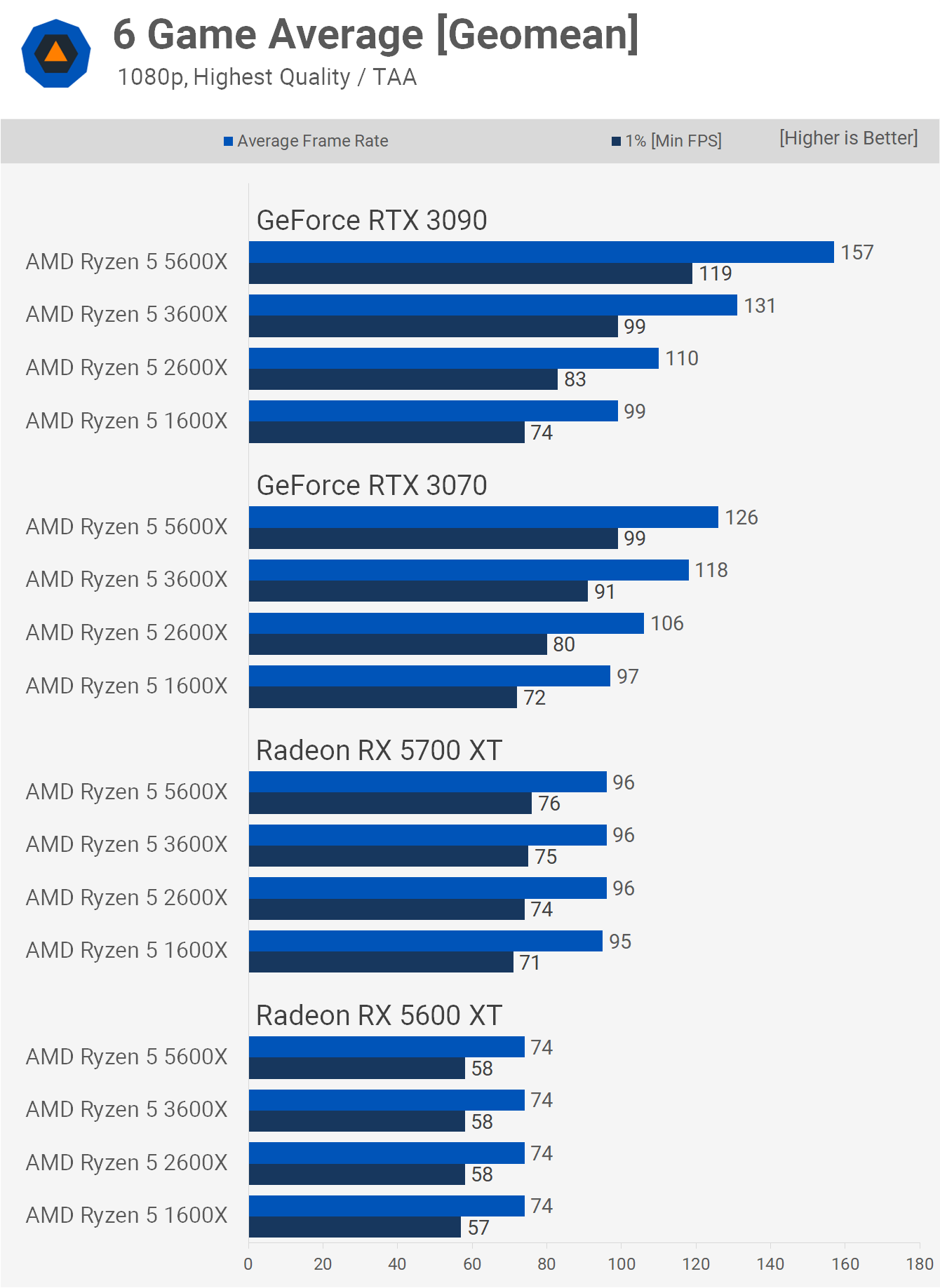
The 31% margin seen with the RTX 3090 is obviously large, but it does drop to 24% with the RTX 3070 and then just 6% with the 5700 XT, a GPU that's comparable in terms of performance to the RTX 3060, RTX 2070 Super and GTX 1080 Ti. What this means is, if you're using the 2700X with a previous generation $400 to $500 graphics card, it's not going to be a great deal slower than the 5800X in most games, and therefore will stand up well against the Core i7-8700K.
However, purely for gaming, the 8700K has aged better as a high-end gaming CPU, and we know this from our CPU review data which includes the Ryzen 7 2700X and the Core i5-10600K, which is basically a Core i7-8700K. In this example, the 2700X was on average 19% slower than the 10600K, and that's about what we were expecting to find based on past efforts comparing these CPU architectures.
For example, we often used to hear from AMD fans that the 2700X would end up being the superior gaming CPU in the future, eventually overtaking the 8700K thanks to the two extra cores. However, we invested quite a bit of time into investigating those claims back in mid-2018 and concluded that for this comparison, no it's not.

The 8700K was and still is the superior gaming CPU, but what that means for gaming will depend on the user and there's certainly no wrong option here. As we said countless times in our Top 5 Best CPU features through 2018 to 2019, if you want maximum gaming performance, go with Intel, pointing to the 8700K and then later the 9900K.
However if you're also interested in doing some core-heavy work, we proposed that the Ryzen 7 2700 series might offer a better balance, and for a good part of its life it was cheaper to purchase, too, dropping as low as $160 in early 2020, which was nuts. Meanwhile, the 8700K used to cost at least $360 in that same period, so it's easy to see why there was so much hype around these Ryzen 7 parts.
The advantage of spending more on the 8700K though is the fact that today you don't really need to upgrade, the jump up from the 10600K, which again is basically an 8700K, to the 10700K, which is basically a 9900K, nets you ~4% more performance. That's a good thing because the 9900K is really the only upgrade option you have on that platform and it's still very expensive, selling for around $300 second hand on eBay, that's about what the Core i7-11700F costs new.
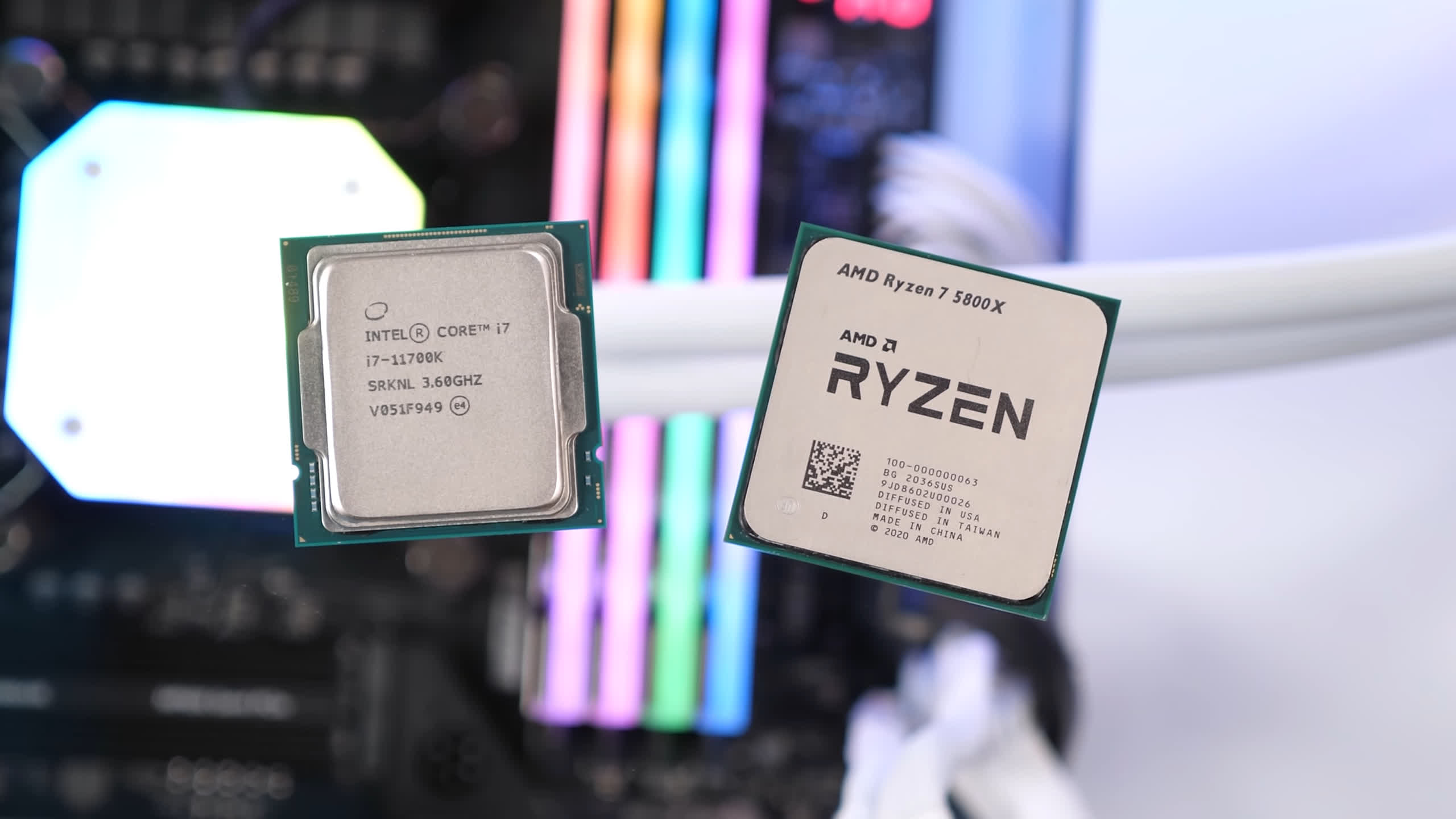
On the other hand, those who were looking to work as well as game, and therefore invested in the 2700X, you now have the option of upgrading to the 5800X, 5900X or 5950X for a tremendous improvement in both gaming and application performance.
As for buying the 2700X in 2021 for a second hand budget build, it's actually not a bad idea and makes sense for the same reasons you would have bought it in 2018, so for productivity and gaming. Typically the 2700/2700X chips sell for $170, while the 8700K costs $200 and you can expect to pay more for a second hand Intel motherboard as well. The newer Ryzen 7 3700X typically fetches about 40% more at $240, and it's not worth that premium and then you're looking at $350 for a second hand 5800X, or $280 for a 10700 series processor.
You can save a bit more on a 1st-gen Ryzen 8-core part, but if you're just gaming and are on a tight budget, a 2nd or preferably 3rd generation Ryzen 5 processor is a much more cost effective alternative. For example, the Ryzen 5 3600 can typically be had for $160 and it's faster than the 2700X in all games we've tested. Of course, the beauty of the AM4 platform is that if you have a half decent 400 or 500 series motherboard, you open yourself up to countless upgrade options down the road.
